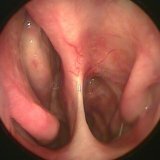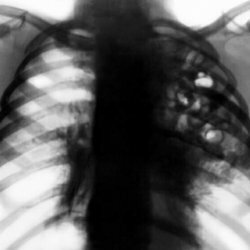Wegener's granulomatosis of the respiratory tract

Wegener's granulomatosis refers to systemic diseases. It manifests as necrotic granulomatous vasculitis. The most common is the generalized form, affecting the lungs, upper respiratory tract and kidneys. About 20% of patients suffer from a limited form of Wegener's granulomatosis, which is accompanied by a lesion of the lungs and upper respiratory tract. This pathology can develop in a person at any age, but most often it affects people aged 30 to 50 years. Men and women get sick with equal frequency.
Causes of
The etiology of the disease has not yet been clarified. Granulomatosis Wegener airways can be triggered by acute respiratory infections, trauma, cooling, drug intolerance, insolation, etc. The disease is systemic, extensive granulomatous reactions mainly in the respiratory system. All this speaks about autoimmune mechanisms of pathology.
Symptoms of
Disease affects men more often. It begins with a defeat of the upper respiratory tract, a persistent runny nose with serous-sucric, purulent secretions, nosebleeds. There may be signs of damage to other organs of the upper respiratory tract. When a tracheobronchial tree is affected, persistent cough, blood-purulent sputum, and pain in the chest are observed. Then the disease passes into the stage of generalization, when the clinical picture is polysyndromic. The patient has fever, migrating polyarthritis, may be arthralgia and myalgia, skin lesions, accompanied by necrotic ulcers on the face. Pathognomonic signs are purulent necrotic and ulcerative necrotic rhinitis, nasopharyngitis, sinusitis, laryngitis. Radiographic examination of the lungs reveals focal and drain pneumonia with the formation of cavities and abscess formation. At this stage, diffuse glomerulonephritis develops in the kidneys and kidney failure progresses.
Diagnosis
Laboratory investigations of Wegener's granulomatosis are not specific. There is a leukocytosis as a sign of inflammation, an elevated indicator of ESR and other. Death of patients comes from pulmonary hemorrhage or kidney failure. Wegener's granulomatosis is difficult to diagnose in the early period and when the disease manifests by pulmonary symptoms. In such patients with biopsy of the nasopharyngeal region( mucosa of the upper respiratory tract), the granulomatous nature of the developing pathology is revealed.
Treatment of
Without adequate treatment, the prediction of Wegener's granulomatosis is poor. About 90% of patients die in 2 years. In the case of signs of kidney damage, the average life expectancy of about 5 months. With this disease, corticosteroids are prescribed, which have a weak effect. However, they can significantly improve the condition of the affected eyes and with arthritis. The main drug in the treatment of Wegener's granulomatosis is cyclophosphamide. This drug is administered internally in a daily dose at a recalculation of 2 mg / kg of weight, that is, 150 mg per day on average. With a rapidly progressing disease, the drug is administered intravenously in the first days. Cyclophosphamide is normally combined with prednisolone, when systemic manifestations occur, joints, eyes, skin, kidney damage. First prednisolone is prescribed in a dose of 40-60 mg / day. With the development of an obvious improvement, you can gradually reduce the dose and transfer the patient to a medication every other day, followed by cancellation. However, the main drug, cyclophosphamide, is taken for a long time. Gradual and slow reduction of its dose, up to complete cancellation, is recommended only after one year after the onset of complete remission.
With adequate treatment, 95% of patients can achieve remission. In many patients, remission after stopping treatment and taking drugs lasts up to 15 years. These data allow us to talk about the possibility of curing Wegener's granulomatosis and complete recovery of patients. The likelihood of developing relapses after withdrawal is small. However, they are amenable to re-assigned treatment.



